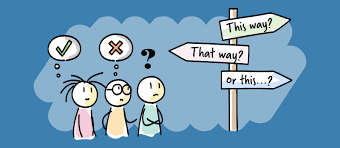
Confused to take the right decision? Check "How to Make Confident Decisions and Change Your Life"

2 Minutes Psychology
Sep 10, 2025
Have you ever been in a situation where you had to choose between different options, and you weren't quite sure which one to go for? Maybe you were deciding what to have for dinner, which movie to watch, or which college to attend. Well, that's what we call decision making!
Decision making is the art and science of picking the best option from a set of alternatives. It's like being a detective, analyzing clues, and figuring out what the best course of action is. It's a process that involves gathering information, weighing the pros and cons, and using your intuition to make the best choice.
Decision making is an essential skill that we all use every day, whether we're aware of it or not. From simple choices like what to wear to work, to more complex decisions like which job offer to accept, our ability to make good decisions impacts our lives in many ways.
So, the next time you find yourself faced with a decision, remember that it's an opportunity to flex your decision-making muscles and choose the best possible outcome for yourself. And who knows, with practice, you might even become a decision-making pro!
Mindfulness: Mindfulness is a practice that involves being fully present in the moment and non-judgmentally observing your thoughts and emotions. By practicing mindfulness for right decision making, individuals can become more aware of their thoughts and feelings, which can help them to make more informed and intentional decisions.
Thought-stopping: This technique involves interrupting negative or unhelpful thoughts by saying "stop" or visualizing a stop sign. Once the thought has been interrupted, individuals can then replace it with a more positive or helpful thought.
Graded exposure: This technique involves gradually exposing oneself to situations or decisions that are anxiety-provoking. By slowly building up exposure, individuals can become more comfortable with making decisions and develop confidence in their ability to do so.
Cognitive restructuring: This technique involves identifying and challenging negative or irrational thoughts that may be impacting decision-making. By replacing negative thoughts with more positive or rational ones, individuals can improve their decision-making abilities and reduce anxiety.
Role-playing: Role-playing can be used to practice decision-making in a safe and supportive environment. By acting out different scenarios, individuals can gain confidence in their decision-making abilities and identify areas for improvement.
Behavioral activation: This technique involves identifying and engaging in activities that bring pleasure or a sense of accomplishment. By increasing positive experiences and reducing negative ones, individuals can improve their mood and cognitive functioning, which can help with decision-making.
Socratic questioning: This technique involves asking a series of open-ended questions to explore and challenge negative or unhelpful thoughts. By engaging in this process of inquiry, individuals can gain a more accurate and balanced perspective, which can inform their decision-making.
Visualization: Visualization involves mentally rehearsing a decision or imagining a positive outcome. By visualizing success, individuals can increase their confidence and motivation to make a decision.
Pros and cons: The pros and cons technique involves making a list of the advantages and disadvantages of each decision option. This can help individuals to identify the potential benefits and drawbacks of each option, which can inform their decision-making.
Written tasks: Writing down thoughts, feelings, and ideas related to the decision can help to clarify thinking and reduce anxiety. For example, individuals can write out a list of priorities, create a decision tree, or write a pros and cons list. This can help individuals to organize their thoughts and make a more informed decision.
Book your consultation now
The pros and cons technique: also known as the decisional balance sheet, can be a particularly helpful tool for decision-making. To use this technique, individuals create a table with two columns: pros and cons. In the pros column, they list all the positive aspects of each decision option, and in the cons column, they list all the negative aspects. This can help individuals to compare the advantages and disadvantages of each option and make a more informed decision.
Overall, CBT offers a range of techniques that can help individuals improve their decision-making skills and reduce anxiety or indecisiveness. By working with a qualified therapist or practicing these techniques on their own, individuals can develop a personalized plan for improving their decision-making abilities.
Good decision-making is important in life for several reasons:
Achieving goals: Making good decisions is essential for achieving our goals, whether they are personal, professional, or academic. Good decision-making helps us to choose the most effective strategies to reach our desired outcomes.
Improving relationships: Good decision-making can improve our relationships with others by helping us to communicate effectively, manage conflicts, and set boundaries.
Reducing stress: Making good decisions can reduce stress and anxiety by reducing uncertainty and providing a sense of control.
Enhancing well-being: Good decision-making can enhance our overall well-being by helping us to make choices that align with our values and priorities.
Building resilience: Making good decisions can help us to build resilience and adapt to new situations, by helping us to learn from past mistakes and make more informed choices in the future.
In contrast, poor decision-making can have negative consequences, such as missed opportunities, strained relationships, financial difficulties, and health problems. Therefore, developing good decision-making skills is an essential life skill that can benefit us in many areas of our lives.
Community
Share your experience
Let's Meet 2 Minutes Psychology
Aug 28
Remember
Let's Meet 2 Minutes Psychology
Aug 28
Cognitive Behavioral Therapy (CBT) and anxiety coping skills
Let's Meet 2 Minutes Psychology
Aug 28
Anxiety coping skills for teens
Let's Meet 2 Minutes Psychology
Aug 28
Grounding techniques
Let's Meet 2 Minutes Psychology
Aug 28
.png)

